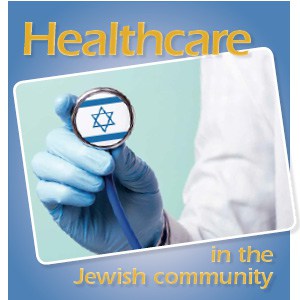Healthcare impacts us all in one way or another. That’s probably why there’s seemingly no limit to articles and shows on the subject, and why we do this section each year.
Our first article on page 18 introduces three young Israeli medical students who are participating in an exchange with EVMS. From their smiles and enthusiasm, it seems medical school is treating them well! Perhaps you’ll see them around town.
Among our other articles is one on a TJF grant to enable JFS to better digitize patient records and another by Moe Mernick on stuttering. He’ll be in town next month for the Ann Zukerman Scholar-in-Residence weekend . Plus, I review
Dr. Lisa Barr’s book, Outsmart Your Pain below.
Of course, there’s more, including a piece on Israel’s medical cannabis research. Who knew?
To everyone’s health!
Terri Denison
Editor
Three Israeli medical students in Tidewater
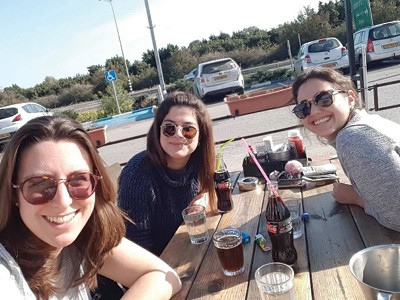
Donna Gal, May Weinberg, and Shelly Cohn in Israel.
Exchange program between Eastern Virginia Medical School and Bar-Ilan University Medical School
Providing high quality community healthcare services to patients at risk both in America and northern Israel is among the major learning insights of medical students participating in an exchange program between Eastern Virginia Medical School (EVMS) in Norfolk, Va., and the Bar-Ilan University Medical School (BIUMS) in Safed, Israel.
Steven Warsof, MD, EVMS professor of Obstetrics and Gynecology, helped bridge the relationship between the two schools. Since the Israeli school opened in 2011, Warsof has taught on numerous occasions at BIUMS.
In an interview with Jewish News in 2015, Warsof noted, “Teaching in Safed combines my three passions—getting closer to my family in Israel, teaching obstetrics, and helping Israel in the best way I know how.”
“With partnerships such as this, the future looks bright for these two institutions,” says Warsof.
The three Israeli medical students, due to arrive in Tidewater soon. say they are excited to participate in the exchange to learn and to compare healthcare systems.
May Weinberg
I come from Haifa, Israel.
I have studied in the Czech Republic for three years and I am now completing my final years of medical school in Israel. The opportunity to study in both countries comes with many advantages. Being able to compare medical systems, to see how healthcare providers from different backgrounds work in their own way and experiencing different people and cultures, has revealed many different perspectives to me. I believe that being exposed to different cultures and systems will help me become a better caregiver and doctor.
Through this exchange program, I am looking forward to learning and expanding my knowledge even more. I am eager to see how U.S. physicians work in a place so far and different from my own.
Donna Gal
Originally from Jerusalem, I am currently living in Nahariya, in northern Israel.
I started my studies in the University of Pavia, Italy and later transferred to graduate in my home country, Israel, at Biums in the Galilee.
I chose to apply to the EVMS exchange program in Norfolk in order to experience the medical life in the U.S. and to deepen my studies in the field of OB-GYN.
I am looking forward to my time in Virginia very much.
Shelly Cohn
I’m from Kochav Yair, and a fifth-year medical student in Biums. I chose to participate in the EVMS exchange because I’m very interested in OB-GYN, as well as seeing different health care systems around the world.
Terri Denison
TJF Community Impact Grants support tech upgrades at JFS
In 2017, Tidewater Jewish Foundation (TJF) awarded a Community Impact Grant to Jewish Family Service (JFS) to help purchase tablets to make it easier for patients in JFS’ home health programs to receive timely and efficient care. Nurses use the devices to smooth the transition for patients from the hospital or other settings to home. The tablets also ease the burden of coordinating paperwork among providers. With electronic medical records, nurses are able to access patient information to ensure the most accurate and timely medical information available.
For JFS, these types of technology upgrades translate to a higher quality of care for a greater number of people. However, over time and with the rapidly changing healthcare industry, these important technology investments can become a cost burden. That’s where TJF is often able to step in.
TJF’s Community Impact Grants are funded through the use of a portion of its Unrestricted Funds.
“Thanks to the generosity of donors throughout the Tidewater Jewish community, our pool of unrestricted funds has grown significantly,” says Scott Kaplan, TJF president and CEO. “This has enabled us to distribute more funds each year through our Community Impact Grants program. Our work with JFS is just one example out of dozens of grants that TJF is able to provide to our local community on an annual basis.”
TJF grants are supplemental to allocations made through the Annual Campaign of the United Jewish Federation of Tidewater, according to Kaplan. TJF grants, he says, “help fund new and innovative programs, capital projects, and other needs that are important, but outside of an organization’s normal operating budget.”
Kelly Burroughs, JFS chief executive officer, says, “Prior to the use of an electronic system, nurses were required to chart everything on paper, which is not the most effective system for collaborating with hospitals and doctors’ offices. The use of an electronic system has helped JFS stay up to date with current health care practices.”
Kaitlyn Oelsner
For more information about how to support Community Impact Grants, call Scott Kaplan at 757-965-6109 or Kaitlyn Oelsner, 757-965-6103.
How stuttering helped me accept and embrace my adversities
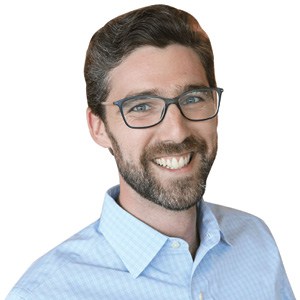
Moe Mernick
Growing up in Toronto, I could have seemed like an ordinary kid. But there was something that made me sharply stand out.
I stuttered. A lot.
It began when I was three years old. My parents were told to ignore it—as “merely a stage in a child’s speech development,” speech experts would say and cite the statistics that most children grow out of it.
But I didn’t grow out of it. In fact, it only got worse.
Not only was it daunting for me to speak up in class or introduce myself to new friends, but I would often get laughed at when I could not even say my own name or the simple word “hello.”
My mom tried to give me positive encouragement. “Moe,” she would tell me, “you have so much going for you…”
But invariably, I would respond that it was all worthless if I couldn’t speak.
I was miserable. I constantly wondered to myself: What would life have in store for me? How would I ever pass a job interview? What girl would want to marry me? What will I sound like when reading bedtime stories to my kids?
After numerous failed attempts to find a speech therapist who fit my needs, a match was finally made. A dozen years of therapy helped, enabling me to function on a daily basis—some days more, some days less. My therapy often consisted of fabricating real-life circumstances while in the stutter-friendly comfort zone of my therapist’s office. We made phone calls and visited stores together, practicing words with which I had difficulty. It gave me hope of normalcy, and I felt accepted, regardless of how my words were expressed.
But I never embraced or fully accepted my stutter. I worried it might be my companion forever. I could not come to terms with the fact that my awkward, embarrassing, and inhibiting speech habits might accompany me through life.
Fast forward to today.
I have been flown around across Canada, the United States, central Europe, and Australia to lecture to Jewish education programs. I received an MBA from Tel Aviv University, worked at Deloitte as a strategy consultant and trained senior-level executives on their presentation skills. These days, I work at a cool start-up and mentor entrepreneurs at a technology accelerator. I live in Israel, with my wife and children.
Indeed, I am living my dream. But what happened?
Therapy helped. My supportive family helped, too. But the ultimate turning point happened when I began to accept my stutter. No longer did I have to reject it or hide from it—it was simply a part of who I was. We all have our challenges—stuttering was mine. It was finally time to live.
Thus, began my journey to discover my inner voice.
Years later, I met a married couple who had just discovered their three-year-old daughter had developed a stutter. I advised them as follows:
As young as your daughter may be, she can pick up on the fact that her parents are extremely worried about her newly developed speech pattern. As such, she will probably become hesitant to speak up because she won’t want to scare you. It is easier for her to keep her mouth closed than to watch your panicked facial expressions when she can’t seem to get her words out.
The more she chooses not to speak, the more anxiety she will build around speaking. Each time she decides that it is safer to not risk the stutter, she, in effect, is subconsciously developing a mental block against expressing those words.
You must create a “safe” environment for her. She must feel that you unconditionally love her and will not be upset or judge her if she begins to stutter. You and your husband must become comfortable with the fact that your daughter may stutter for the rest of her life. And it is OK.
The ball is in your court. The more accepting you become, the less your daughter will feel as though you are trying to change her.
Ironically, by becoming comfortable with the fact that your daughter may stutter permanently, you are providing her with the best chance to overcome it. The safe haven of your home will hopefully help her develop a strong self-confidence. You will thereby significantly increase the probability that your daughter’s stutter will be but a blip on her early-childhood radar screen.
Please note, though, that you cannot expect her to overcome it. That is, in effect, the opposite of true acceptance of her stutter. She will sniff out your insincerity. Therefore, I strongly suggest that you and your husband have an important conversation, whereby you recognize the limit of control you hold over every aspect of your daughter’s stutter.
I am confident that you will see results. Because even if she does not stop stuttering, your relationship with your daughter will no longer be one of deflated hopes and frustration, but rather one of idyllic parental love and unwavering support. This can only be beneficial for all three of you.
I was excited to hear that this little girl’s stutter faded away the following year. But it was even more powerful to receive the feedback that my advice was both novel and refreshing. I was lauded for my unique approach to stuttering and praised for having such a healthy attitude. That was meaningful to me, especially after years of frustration and anger over my own stuttering.
But it also irked me. Why had this family not heard this advice from others? Was my approach that unique? And then I realized that what I was saying didn’t only apply to stuttering.
We all face our own unique adversity and choose our response. It is not about conquering our challenges, but rather about embracing them, improving our self-esteem, and leading happier, more meaningful lives as a result.
Moe Mernick
Hundreds of haredi Orthodox attend symposium with leaders of anti-vaccine movement
(JTA)—Jews are being persecuted as disease carriers amid the outbreak of measles, a New York haredi Orthodox rabbi said at a symposium with leaders of the anti-vaccination movement attended by hundreds of haredim.
“We Hasidim have been chosen as the target,” said Rabbi Hillel Handler, a Holocaust survivor from Monsey, a Rockland County town with a large haredi population, according to the New York Times. “The campaign against us has been successful.”
The Centers for Disease Control has reported a total of 839 cases of measles in 23 states as of Monday, May 13, the highest number since 2000, when measles was considered eradicated. The outbreak has been centered in New York City and state: The city alone has seen 498 confirmed cases since September, with a large number in Orthodox neighborhoods in Brooklyn. In the rest of New York state there have been 274 confirmed cases, according to official figures, with about 80 percent located in Rockland County.
The CDC pinned the resurgence on the unvaccinated and those who brought back measles from other countries. The outbreaks in Orthodox Jewish communities have been associated with travelers who carried the disease back from Israel and Ukraine, according to the CDC.
Among the speakers at the Monsey event were Dr. Andrew Wakefield, the British physician whose study linking measles vaccines with autism has been condemned, appearing via Skype; and pediatrician Dr. Lawrence Palevsky, who is regularly cited in pamphlets circulated in New York City that urge women not to get their children vaccinated, the Times reported.
Palevsky said failed vaccines are being given in the haredi communities.
“Is it possible that the measles-mumps-rubella vaccine that is somehow being given in this lot to communities in Williamsburg and Lakewood and Monsey, maybe in Borough Park, is it possible that these lots are bad?” he asked, referring to areas in New York and New Jersey with large haredi communities, the Times reported.
“It’s fascinating because we’re told how contagious the disease is, but somehow it’s centered in the Jewish community.”
The meeting, which featured separate seating to accommodate the religious observance of the haredi community, was denounced by local elected officials, health authorities, and some haredi rabbis, according to the newspaper.
Last month, New York City Mayor Bill de Blasio declared a public health emergency over the measles outbreak in Brooklyn’s haredi Orthodox community. De Blasio ordered unvaccinated people living in four ZIP codes in the Williamsburg neighborhood to get the vaccine or be required to pay fines of up to $1,000.
Despite institutional pressure, a strain of opposition to vaccines has persisted in haredi communities based on false claims that vaccines are ineffective at best and harmful at worst. Large families, close-knit communities and the complexity of timing immunizations for a family’s many young children also have contributed to the outbreak.
The majority of Orthodox Jewish children are vaccinated, according to statistics issued by the New York state and New York City health departments. There is no religious reason not to be vaccinated. Prominent rabbis in New York have called on their followers to vaccinate their children.
Meanwhile, on Monday, May 13, the Yeshiva of Central Queens was ordered closed after failing to comply with a Health Department order to prevent unvaccinated students from coming to school. It is the ninth Orthodox Jewish school to be ordered closed over the measles epidemic, but the first outside of Brooklyn.
The following day, hundreds of New York parents against vaccinations rallied outside the state capitol in Albany calling on lawmakers to protect a state law that permits people not to vaccinate their children for religious reasons, The Associated Press reported. Some lawmakers have proposed eliminating the religious exemption in light of the current measles outbreak.
Also on Tuesday, May 14, de Blasio’s office released a video calling on the Orthodox Jewish community to vaccinate their children featuring a prominent member of the Hasidic community—Alexander Rapaport, executive director of the Masbia soup kitchen network.
Marcy Oster
US turns to Israeli know-how for medical cannabis research
SAN FRANCISCO (J. The Jewish News of Northern California via JTA)—When Israeli plant scientist Nirit Bernstein got a call five years ago from a research institute asking if she’d be interested in working on the cultivation of medical cannabis, she said yes. But then a thought quickly crossed her mind.
“Oh my god,” she thought. “What’s my mother going to say?”
Bernstein studies whole-plant cannabis at Israel’s state-run Volcani Institute and was one of several experts in various fields, including science, medicine and business, who met in San Francisco May 1–2 for the inaugural CannaMed/Tech Summit, produced by the California Israel Chamber of Commerce.
“I hope from Israel your science gets over here quicker rather than later, because we need it,” said investor Matthew Nordgren, CEO of Arcadian Fund and one of the keynote speakers. “We need it. We need to understand this plant.”
While there is much hope and optimism about medical cannabis, there are also many questions—and businesses and investors in California and the U.S. are relying on Israel for some of the answers. It’s easier to learn about the multifaceted plant in Israel, which not only allows research but also funds it, unlike in the U.S., where strict federal laws are an impediment to clinical studies. (Recreational marijuana is not yet legal in Israel.)
Hebrew University’s Multidisciplinary Center for Cannabinoids Research, for example, is studying possible applications for drugs targeting cancer, migraines, inflamed tissue, stress, pain, and renal disease.
At Volcani, Bernstein is working on how to use light, heat, fertilizer, and growing conditions to standardize the compounds in cannabis. (The best-known are THC and CBD, both first isolated by Israeli pharmacologist Raphael Mechoulam in the mid-1960s.) She said growing cannabis on a large scale is much more difficult than raising a conventional farm crop.
“Cannabis is not a tomato!” she says.
In cannabis grown by small farmers, the active compounds are not always consistent—they can be stronger at the top of the plant, or vary from plant to plant. Bernstein says it would be like giving a patient different amounts of aspirin and never telling the person the dosage.
“If you want to treat [cannabis] as a drug, you have to standardize it to an acceptable level,” she says.
Further complicating the issue of dosage is drug delivery, or how the active elements of cannabis get into the body, whether taken intravenously, orally, or through smoking, says Professor Simon Benita from the School of Pharmacy at Hebrew University.
“How much drug will reach the blood?” he asks. “Because everything else is wasted.”
A host of factors makes it especially difficult to study these issues in the U.S. While the use of recreational and medical cannabis is legal in California, researchers who want to conduct clinical trials still have to deal with restrictive federal rules, says Donald Abrams, an oncologist at UCSF Medical Center and San Francisco General Hospital.
So far, the FDA has approved only one drug using cannabis compounds: Epidiolex, which treats epilepsy. The rest of the products sold in California and other states where medical marijuana is legal are handled more like vitamins or supplements, subject to fewer regulations. What manufacturers and sellers promise may be heavy on the marketing and light on the science. But patients and doctors alike are still turning to the plant for its reported healing properties.
“There isn’t a day that goes by that I don’t recommend cannabis to my patients,” Abrams says.
The demand for medical cannabis makes Israel an important partner for businesses wanting to join the green boom, one of the goals of CICC’s executive director Sharon Vanek, who initiated the conference. Attendee Boris Shcharansky, chief operating officer for wellness company Papa & Barkley, says his company had turned to Israel to conduct product research without all the red tape of the U.S.
“Israel doesn’t have any of that,” he says. “That’s amazing.”
Michael Mendez of Renew Biopharma says that a stigma persists in the U.S. around cannabis, which is classified as a Schedule 1 drug along with heroin, LSD, and ecstasy.
“I definitely don’t see that stigma in Israel,” he says. “So they are way ahead of us.”
Until U.S. regulations and attitudes change, businesses and health professionals will continue to seek Israeli expertise on the green plant, partnerships that the California Israel Chamber of Commerce is encouraging.
Already, many see Israel as the place to go for advanced information on medical marijuana.
“It is fast becoming the land of milk, honey—and cannabis,” Israel’s S.F.-based Consul General Shlomi Kofman says with a laugh, after opening the conference. “There are lots of versions of this, but this is the latest one.”
Maya Mirsky
More than pain, this book is also about lifestyle
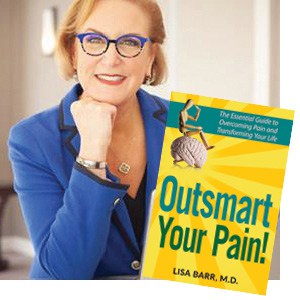
Lisa Barr, MD.
Outsmart Your Pain!
The Essential Guide to Overcoming Pain and Transforming Your Life
Lisa Barr, MD
Illustrations by Tim Sovine
Synergy Health Quest, LLC, 2018
ISBN 13: 978-1-7320011-0-7
In the opening pages of Outsmart Your Pain!, Lisa Barr, MD, says, “The science of pain is always changing.” Two pages later, she notes, “The purpose of this book, and my mission in life, is to help you gain a better perspective of what pain is, what it isn’t, and what you can do about it.”
In fact, Outsmart Your Pain! is an easy-to-read book that not just helps, but encourages readers to learn to help themselves lead a healthier, more balanced, and ultimately, pain-free life.
But readers don’t have to be in pain to benefit from the read. While Barr explains how stress causes pain, for example, her suggestions on reducing and controlling stress are valuable lessons whether you are in pain or not. The same goes for the section on sleep. And, for the pages on nutrition. Likewise, when Barr discusses perfectionism, which, she says in many ways is perfectly paired with pain. In other words, the book offers myriad ways to enhance the reader’s lifestyle and improve daily practices—even if already pain-free.
Of course, for those who do suffer from chronic pain, Barr addresses topics such as drugs, emotions, inflammation, and pain triggers, among many other causes and results of pain.
Barr suggests ways to “kick the pain habit and master your pain” in order to lead a productive and satisfying life. She also discusses preventative measures.
Barr’s writing style is conversational, making the book an easy read. Written from the perspective of her experience as a board-certified pain physician, Barr writes as if she’s speaking to her patients, creating an instant connection between author and reader.
One section of the book that I wish had been included is an index. Perhaps in the next edition.
A Norfolk native, Lisa Binder Barr is a graduate of Eastern Virginia Medical School. She is a board-certified physiatrist with a practice in Virginia Beach.
Reviewed by Terri Denison
Terri Denison is editor of Jewish News.
Pushing forward a vision for women’s health
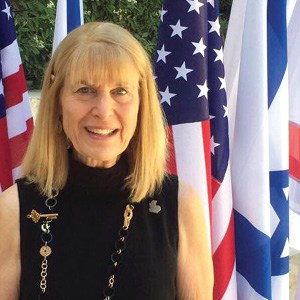
Ellen Hershkin
“Self-care” is the buzzword of the moment for women, but what does it really mean when women’s health disparities in America have elicited a growing alarm among the public and policymakers? Women need real tools to help navigate their own health, from education, to apps to community resources. But the burden and responsibility shouldn’t fall only on them. “Self-care” isn’t a trend, but a proven combination of patient and clinician-driven practices. Health is not just about treating disease, but about living life optimally.
There are so many ways we can improve and uplift women’s health as a society: from turning around the dismal American maternal mortality rates (the worst in the developed world), to spreading the message that heart attack symptoms in women are often overlooked compared to those in men. We must embrace a comprehensive vision for moving forward on a personal and structural level. What is needed is a combination of solutions: the time and ability to exercise and eat healthier combined with ongoing education about women’s unique health issues. In addition, a holistic approach from the medical establishment that goes beyond regular well-woman visits, preventative testing, and counseling is also required.
To achieve this vision, we must address how presumed gender roles impact our everyday lives. According to the US Department of Labor, “women in the United States make approximately 80% of the health care decisions for their families.” Women are often the CEO’s of their families’ health, keeping track of appointments, medication, and the general well-being of spouses, children, and elderly or infirm relatives. These responsibilities often don’t leave women enough time for genuine self-care and self-monitoring. Women may also be conditioned to grit their teeth through discomfort rather than getting help early or prioritizing visits to the doctor.
In clinical settings, perceptions of gender can also affect women negatively. When research subjects are overwhelmingly male, women’s experiences may not be as familiar to practitioners. As one writer for the Harvard health blog noted, “70% of the people [chronic pain] impacts are women. And yet, 80% of pain studies are conducted on male mice or human men.” This reality also means that women’s pain may not register as severe—even though doctors have acknowledged that menstrual cramps can be as painful as a heart attack! All of these factors arise from ideas subtly ingrained in our social structures.
As economist Carolina Crialdo-Perez writes in her new book Invisible Women: Exposing Data Bias in a World Designed for Men a “male norm” persists in everything from seatbelts to cancer studies. Women walk through a world that’s simply not engineered for them. Many patients of all genders go through a siloed medical system focusing on individual symptoms rather than holistic care. Women are more likely than men to see multiple providers regularly. This is particularly problematic for women whose present-day health issues may, for instance, be traced back to a previous pregnancy or another reproductive or hormonal issue
Hadassah is committed to making that totality of care a reality for as many women as possible, by demonstrating quality practices in our own health centers in Israel in addition to spreading the word in our education campaigns and advocating for policy changes here in the US.
Women’s health care should be integrated, especially since women’s primary point of contact may not be limited to a single provider. The Hadassah Medical Organization offers treatment at every age and stage, based on best practices and data, with a focus on understanding when certain women are at greater risk. For example, the Fleischman Center for Women’s Health at Hadassah Hospital Ein Kerem pioneered the concept of a “one and only” clinic, which provides women with an entire slate of tests and visits from which to choose, such as: mammograms, dietician consultations, bone density tests, and pap smears. Patients leave with a road map for holistic health. Across our facilities, our computerized system linking patients and their doctors, “My Hadassah” allows doctors to understand the breadth of a patient’s history, and offer tailored, personalized care.
Hadassah founded the Coalition for Women’s Health Equity in 2016 to address inequities in prevention, research, access and quality of care, funding, and support. Our 28 coalition members are all working in their own ways to further this vision. Together, we are committed to improving women’s health outcomes—through stakeholder collaboration, public education, and legislative advocacy.
This year, we applaud advancements made by policymakers and the medical system to address health disparities and improve women’s health safety. But far more can be done. We urge policymakers to keep a comprehensive vision in mind and work to promote wellness, integrated care, and a commitment to rigorous research, data collection, and innovation. We encourage members of the medical community—researchers, clinicians, and administrators—to join us in breaking down silos, to collaborate across disciplines, and to continue finding new ways to optimize patient care.
Finally, we must all be our own and our sisters’ keepers. Together, women and men, we can advocate for ourselves and the women around us—a daily reminder that our health is too important to ignore.
Ellen Hershkin
Ellen Hershkin is national president of Hadassah, the Women’s Zionist Organization of America, Inc. (HWZOA).

